Substance Abuse Prevention and Control
Harm Reduction
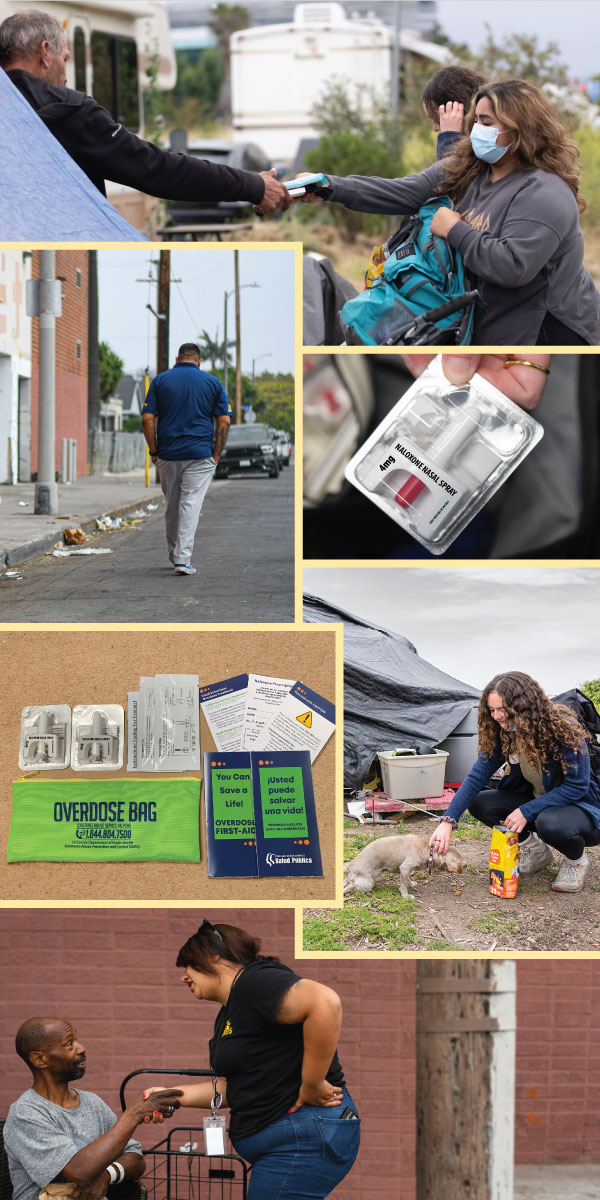
Harm Reduction Unit
The Division of Substance Abuse Prevention and Control’s (SAPC) Harm Reduction Unit is focused on expanding access to harm reduction and overdose prevention services provided by Los Angeles County’s Department of Public Health’s contracted Engagement and Overdose Prevention (EOP) Hubs, also known as syringe service providers, to reduce the number of deaths related to opioid overdoses in LA County.What is Harm Reduction?
Harm reduction is an evidence-based public health approach that aims to reduce the negative consequences associated with substance use.
Harm reduction focuses on:
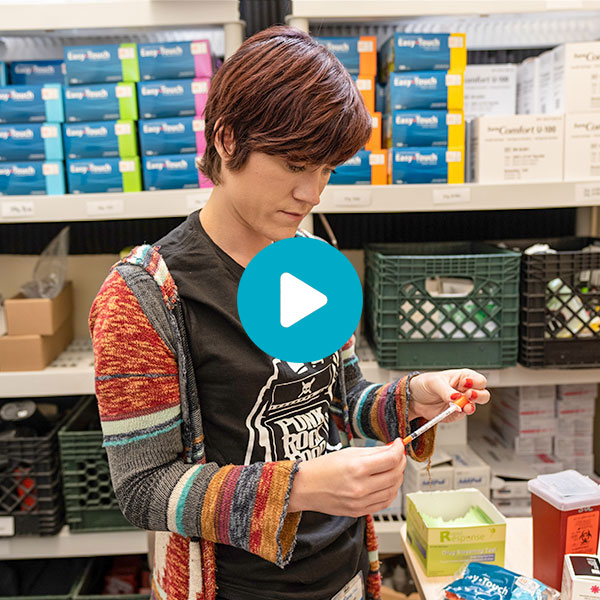
Harm reduction adopts a variety of safer use strategies including:
Statement on Harm Reduction Services in Santa Monica. (Updated - February 2024)
- "Meeting people where they are".
- Recognizes that many people aren’t willing or able to stop using substances.
- Focuses on decreasing the negative consequences associated with drug use.

Harm reduction adopts a variety of safer use strategies including:
- Syringe service programs.
- Providing medications for addiction treatment (MAT).
- Peer programs.
- Safe consumption sites and more.
Statement on Harm Reduction Services in Santa Monica. (Updated - February 2024)
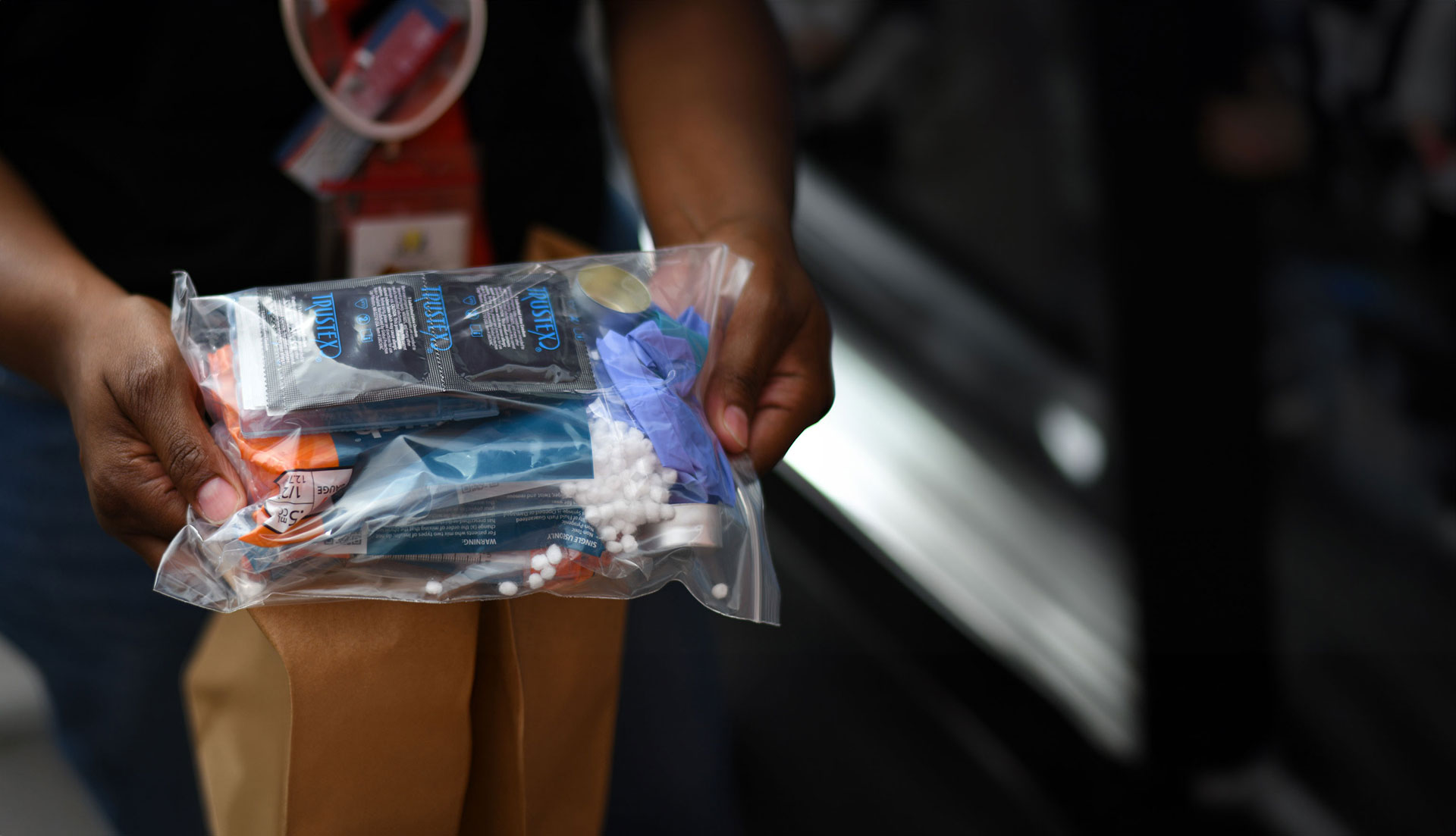
Top 5 Myths
Learn about the myths surrounding Harm Reduction.
-
Is harm reduction evidence-based?
Yes. The goal of harm reduction is to reduce risk, such as the risk of overdose and infection associated with substance use and other behaviors. Harm reduction also accepts that risk is inherent to many human activities. Examples of effective harm reduction programs include wearing a helmet or a seatbelt, arranging for another driver after having too much to drink, or taking medications for diabetes, high blood pressure, or high cholesterol.
Harm reduction strategies reduce the negative consequences associated with drug use through practical steps, such as making naloxone (an opioid overdose antidote) widely available to reverse opioid overdose and providing sterile syringes to people who use drugs to help prevent infection. Scientific studies of these harm reduction interventions demonstrate clear reductions in overdose deaths and infections when harm reduction services are offered in a community.
Getting people to stop using drugs is not the main objective of harm reduction, although the goals of harm reduction can include an individual’s decision to choose abstinence. Harm reduction aims to prevent the spread of communicable diseases, reducing overdoses, and offering people the resources they need including housing, medical, substance use treatment, and mental health services. -
Is there oversight of harm reduction services?
Yes. Los Angeles County financially supports and certifies organizations to offer a series of harm reduction services to people living in Los Angeles County. These include:
- Sterile syringe distribution and collection: Giving someone sterile (unused) syringes (needles) will decrease the spread of blood-borne infections such as HIV and Hepatitis because they will not need to share or reuse syringes. Harm reduction programs distribute sterile syringes and collect used syringes in the community.
- Sterile smoking equipment distribution: If people are smoking their drugs, providing clean smoking equipment can decrease the spread of any infections spread through saliva or infections in the throat or lungs. Smoking drugs has a lower risk of overdose compared to injecting drugs.
- Other sterile supplies: Sterile water, alcohol swabs, filters, tourniquets, mouthpieces, and lip balm reduce the risk of infection or other health complications.
- Naloxone: During an opioid overdose, a person can stop breathing and can die. Naloxone is the life-saving emergency medication that reverses an opioid overdose and allows a person to breathe normally again.
- Testing strips and other drug checking: Drug testing strips are available for fentanyl, xylazine, and benzodiazepines to check whether there are any unexpected substances contained in a supply of drugs. Drug checks using laboratory equipment is also available at designated community centers. Drug checks help people make informed decisions about the drugs they might use and help reduce unintended consequences, such as overdose.
- Medications for Addiction Treatment (MAT): These prescription medications aid the recovery process by decreasing cravings, alleviating withdrawal symptoms, and contributing to a greater sense of well-being.
- Wound care services: Bandages, antiseptic and alcohol swabs prevent or minimize infections or other skin complications for people who are using drugs.
- Primary care, or specialized medical or mental health care: Routine healthcare can catch illnesses early and stop them from becoming more serious. Having access to specialty medical or mental health treatment can also reduce any serious problems that could worsen someone’s health.
- HIV and Hepatitis C testing and treatment: By ensuring that people know their HIV and Hepatitis C status, harm reduction programs decrease rates of transmitting the infections and connect people to necessary medical treatment.
- Substance use treatment: Harm reduction programs provide access to residential care (where people live on-site at a treatment program) or outpatient care when people are ready to participate in substance use treatment.
- Peer support: It can be helpful to have someone who has lived experience with substance use to create a non-judgmental and caring environment. Peers can understand the challenges, struggles, and stigma faced by people using drugs and can build trust.
-
Are harm reduction services only offered in parks and streets?
No. LA County Department of Public Health supports a network of Engagement and Overdose Prevention (EOP) Hubs through which people in LA County can access harm reduction services. A full list of addresses and hours of operation can be found here. Additionally, naloxone is available through pharmacies in LA County as described here and through the access points listed on the LA County Department of Health Service’s Overdose Education Naloxone Distribution Program. LA County-contracted harm reduction services include daily outreach to people who are at the highest risk of overdose.
-
Do people need to provide identification to receive these services?
No. Los Angeles County minimizes barriers to harm reduction services. At some programs, people may be asked to provide initials and a date of birth which can help the contracted agency quantify how many people are receiving services. People who do not provide this information are still offered services. LA County is committed to expanding access to harm reduction services and advancing the health, well-being, and safety of all our residents, regardless of insurance or immigration status.
-
Do harm reduction services encourage drug use?
No. Harm reduction does not encourage drug use. In fact, people using harm reduction services are five times more likely to participate in drug treatment and three times more likely to reduce or stop injecting than those who have never accessed harm reduction services.
Like wearing a helmet or seatbelt, harm reduction does not promote or increase drug use any more than using these safety measures promote reckless behavior in biking or driving. Research from the Centers for Disease Control and Prevention (CDC), the National Institute on Drug Abuse (NIDA), and various state and community-based organizations shows that when people who use drugs interact with an organization offering harm reduction services, they are more likely to enter substance use treatment, detox, or to stop injecting drugs.
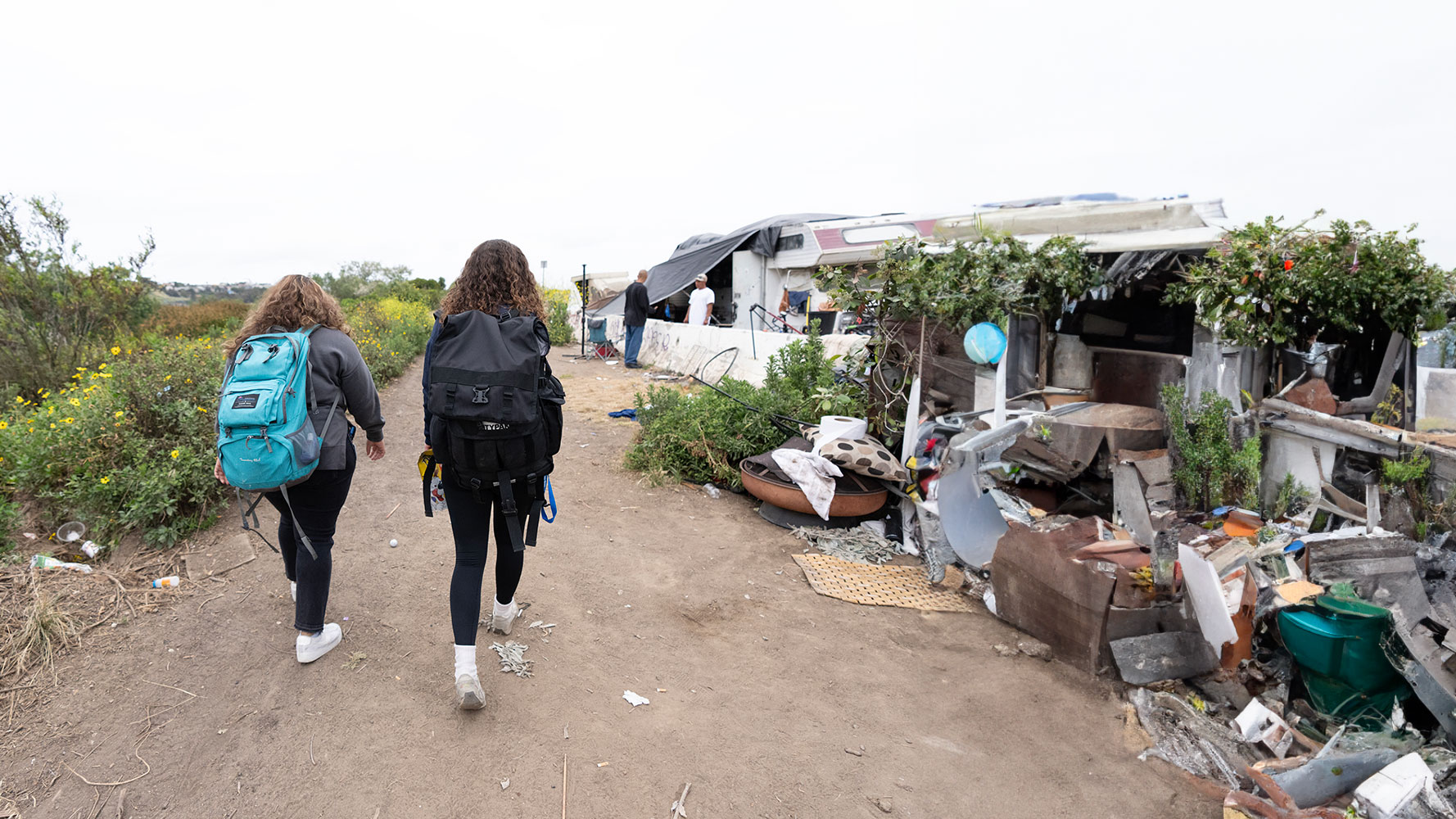

The Overdose Epidemic
The overdose epidemic has resulted from many causes leading to a staggering increase in opioid-related deaths. Explore the following sources in understanding the history of the use of opioid and other drugs and the causes of the present-day epidemic.
- A History of the Drug War
- Understanding the Opioid Overdose Epidemic
- United States Overdose Prevention Strategy
DPH-SAPC Op-Ed on the Drug Overdose Crisis
For SAPC Data Reports and Briefs, click here.
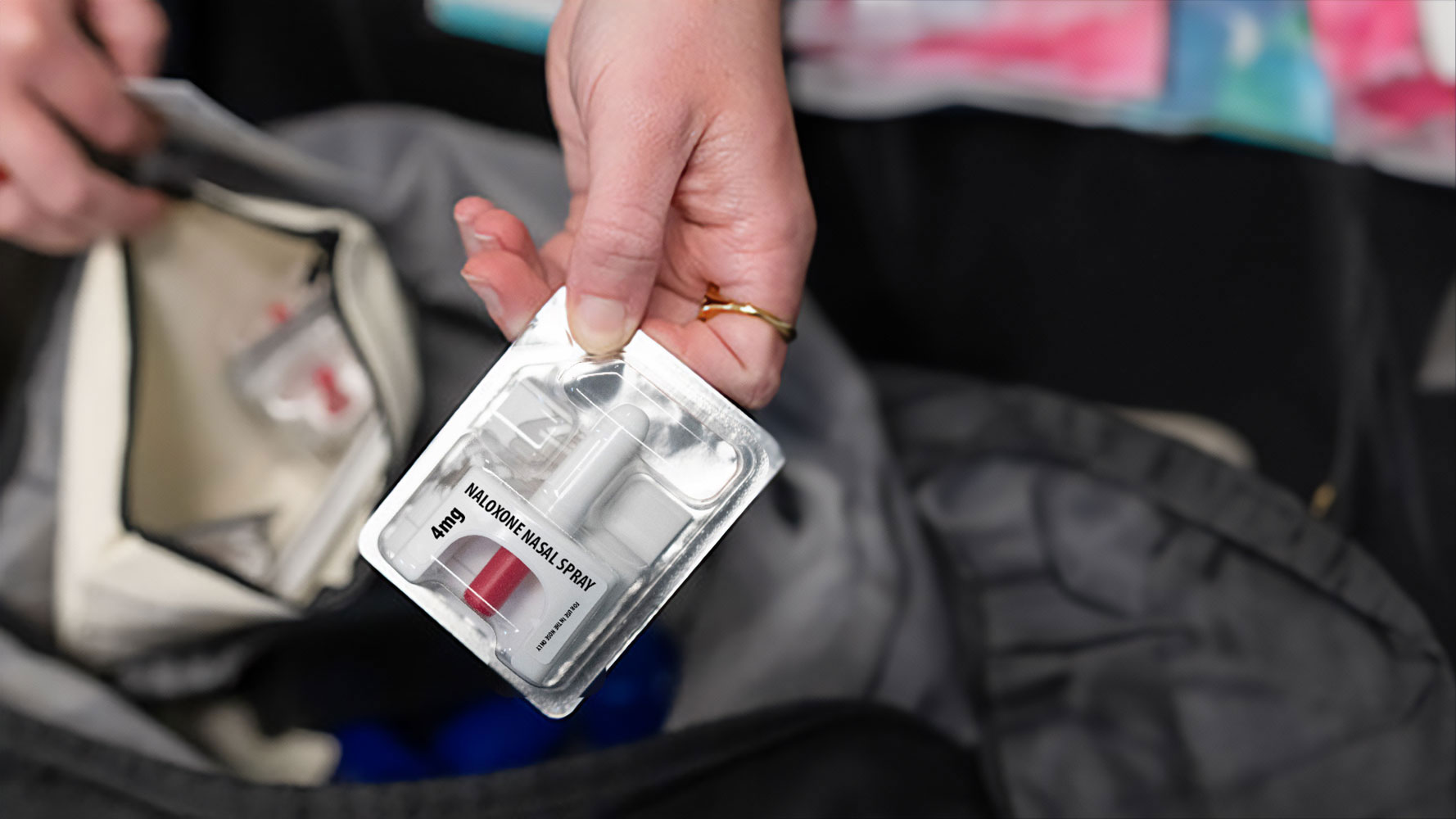
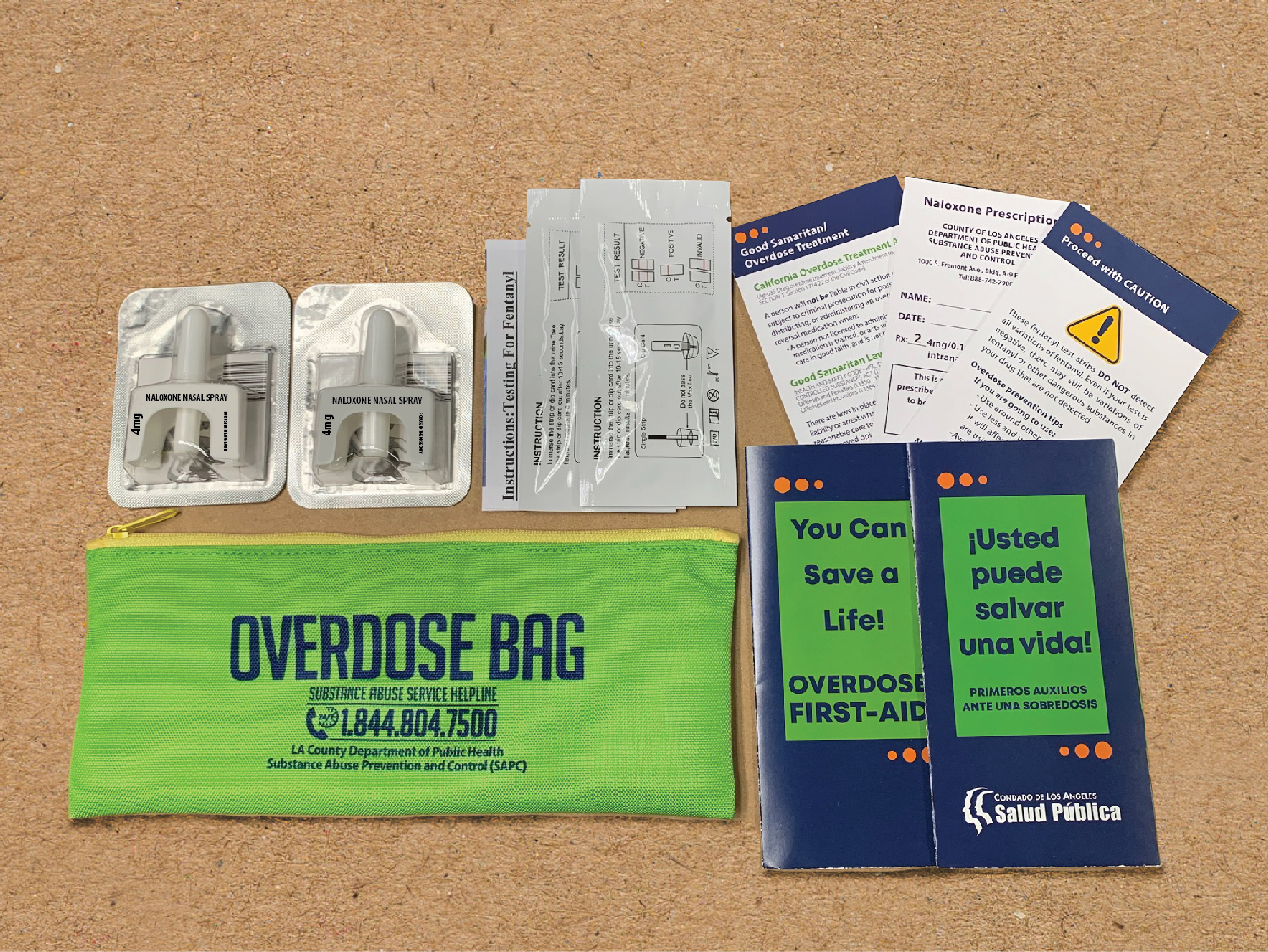
Accessing Naloxone, Drug Testing & Test Strips
Naloxone is a Food and Drug Administration (FDA) approved medication that reverses an opioid overdose. It acts as an opioid receptor antagonist – meaning that it binds to opioid receptors and reverses and blocks the effects of other opioids. In the event of an opioid overdose, naloxone can quickly restore breathing to an individual whose breathing has slowed or stopped.Access Naloxone from a Pharmacy
Naloxone is available to people with Medi-Cal and Medicare with a prescription from their doctor or can be supplied by participating pharmacies without a prescription. Additionally, many private insurances also cover the cost of naloxone, for more information call your insurance provider.
Pharmacy Locations that Furnish Naloxone without a clinician’s prescription.
- Naloxone for Purchase Over-The-Counter
- Contact the pharmacy directly to confirm the availability of pharmacist-dispensed naloxone billed to health insurance.
Pharmacists interested in supplying naloxone may visit the California State Board of Pharmacy website. Distributing Naloxone in LA County
The California Department of Health Care Services’ (DHCS) Naloxone Distribution Project (NDP) is an initiative to prevent deaths due to opioid-related overdose through the provision of free naloxone.
All NDP applicants must submit a prescription or standing order for naloxone. If an organization does not have a standing order, one can be obtained from the California Department of Public Health’s website.
Administering Naloxone
The Overdose Education and Naloxone Distribution (OEND) program is a program of the Los Angeles County Department of Health Services (DHS) which aims to reduce opioid overdose deaths in LA County by teaching people at risk of an overdose, and those close to them, how to prevent, recognize and respond to overdose using naloxone. OEND includes a list of existing community naloxone access points prioritizing naloxone for individuals at highest risk for overdose.
- OEND, LA County DHS: Overdose Prevention Training Video
- CA Public Health: Administering Naloxone Video
- SAPC Naloxone & Harm Reduction Training
Fentanyl is a powerful synthetic opioid that is similar to morphine but is 50 to 100 times more potent causing a sharp, nationwide increase in overdose deaths involving illicitly manufactured fentanyl which has contaminated heroin, methamphetamine, ecstasy, illicitly manufactured pills, and other recreational drugs. Fentanyl test strips (FTS) are a form of inexpensive drug testing technology that can help detect the presence of fentanyl and other fentanyl-analogs in a drug sample prior to use.
Information about fentanyl testing is available via: CDPH Fentanyl Testing Fact Sheet
Fentanyl Test Strips can be accessed via:
Fentanyl Test Strips can be purchased via the vendor listed below:
- Team Awareness Combating Overdose (TACO)
- BTNX: Harm Reduction
- Wise Batch: Harm Reduction
- DoseTest: Fentanyl Test Strips
Xylazine is a sedative drug used by veterinarians to anesthetize animals that is increasingly present in the illicit drug supply. Xylazine is not safe for use in humans and may result in serious and life-threatening side effects including skin wounds, low blood pressure, slowed heart rate, and slowed breathing. People should administer naloxone during an overdose to block any opioids involved in an overdose, even if that overdose may involve xylazine, and call 911 to ensure that the person who overdosed obtains emergency medical care. Xylazine test strips (XTS) are a form of inexpensive drug testing technology that can help detect the presence of xylazine in liquid or powder substances. However, XTS do not show the amount, purity, or potency of the xylazine in the sample.
Xylazine Test Strips can be accessed via:
- The Engagement and Overdose Prevention (EOP) Hubs listed below
Xylazine Test Strips can be purchased via the vendors listed below:
Spectroscopy toxicology testing, that can test a variety of substances, is available for people that use drugs in LA County. Residents of LA County can consider bringing their drugs to be tested at part of a pilot program being run through UCLA, which uses Fourier-transform infrared spectroscopy (FTIR) machines to analyze drug samples in about 15-20 minutes and is available for free through http://www.drugcheckingla.com or through contacting checkingLA@proton.me for locations and hours.
Alternatively, selected Engagement and Overdose Prevention (EOP) Hubs may offer spectroscopy toxicology testing. Please refer to the list of EOP Hubs below to inquire about the availability of on-site drug checking services.
Finding Harm Reduction Services
Engagement and Overdose Prevention (EOP) HubsThe Engagement and Overdose Prevention (EOP) Hubs are LA County contracted syringe service providers who provide harm reduction services, peer-led education, and peer-led support services. Harm reduction services include conducting syringe exchanges, providing safer use supplies including safer smoking equipment, distributing naloxone overdose reversal kits, and connecting participants to other important services and programs such as:
- Education about overdose prevention and harm reduction practices.
- Naloxone distribution and education.
- Screening, care, treatment for viral hepatitis and HIV.
- Referrals to medications for addiction treatment, and other medical, mental health, and substance use disorder (SUD) treatment services.
- Fentanyl test strips distribution and education.
Click here to view EOP Hub Program Schedule (PDF)
Map Legends
 Storefront / fixed locations
Storefront / fixed locations Off-site/Mobile locations
Off-site/Mobile locations
Harm Reduction and Overdose Prevention Resources
Community-based organizations and individuals may utilize the following resources and information designed by SAPCs Harm Reduction Unit to support efforts to expand access to harm reduction and overdose prevention services.-
Fentanyl Resources
- Fentanyl in LA County
- English04/05/23
- Armenian (Հայերեն)04/05/23
- Chinese Simplified (简体中文)04/05/23
- Chinese Traditional (繁體中文)04/05/23
- Farsi (ﻓﺎرﺳﯽ)04/05/23
- Korean (한국어)04/05/23
- Spanish (Español)04/05/23
- Tagalog (Filipino)04/05/23
- English
- Fentanyl in LA County - Talking to Parents and Youth
- English04/05/23
- Armenian (Հայերեն)04/05/23
- Chinese Simplified (简体中文)04/05/23
- Chinese Traditional (繁體中文)04/05/23
- Farsi (ﻓﺎرﺳﯽ)04/05/23
- Korean (한국어)04/05/23
- Spanish (Español)04/05/23
- Tagalog (Filipino)04/05/23
- English
- Fentanyl in LA County - Learn about Naloxone
- English04/05/23
- Armenian (Հայերեն)04/05/23
- Chinese Simplified (简体中文)04/05/23
- Chinese Traditional (繁體中文)04/05/23
- Farsi (ﻓﺎرﺳﯽ)04/05/23
- Korean (한국어)04/05/23
- Spanish (Español)04/05/23
- Tagalog (Filipino)04/05/23
- English
- Fentanyl in LA County - Get Informed, Stay Safe (for Teens)10/18/22
- Fentanyl and Overdoses in Los Angeles County - A Resource Toolkit for Parents11/16/22
- Fentanyl and Overdoses in Los Angeles County - A Resource Toolkit for Students11/16/22
- Fentanyl and Overdoses in Los Angeles County - A Resource Toolkit for Teachers and School Staff10/31/22
- Fentanyl Exposure Risks for First Responders08/21/23
- How to Use Fentanyl Test Strips11/01/23
- Fentanyl Test Strip Info Guide06/27/24
- Fentanyl Test Strip Info Guide - Spanish07/08/24
- Fentanyl in LA County
-
Xylazine Resources
- Xylazine in LA County
- English06/27/23
- Armenian (Հայերեն)06/27/23
- Chinese Simplified (简体中文)06/27/23
- Chinese Traditional (繁體中文)06/27/23
- Farsi (ﻓﺎرﺳﯽ)06/27/23
- Korean (한국어)06/27/23
- Spanish (Español)06/27/23
- Tagalog (Filipino)06/27/23
- English
- Xylazine in LA County
-
Naloxone Resources
- Syringe Possession Wallet Card06/16/22
- Intranasal Vs Injectable Naloxone Information Sheet06/16/22
- SAPC Naloxone Resource Guide02/01/24
- EOP Hub Program Schedule10/12/22
- Syringe Possession Wallet Card
- Training and Presentations
-
Health Resources
- LAC DPH SAPC Wound Care Info Sheet02/08/24
- LAC DPH SAPC Wound Care Info Sheet
-
Local, State and National Resources
- State and National Resources
- Local Resources
Frequently Asked Questions (FAQ)
-
How do you know if harm reduction is really working?
The overarching goal of harm reduction is to decrease the negative consequences from substance use on the individual and the community. 30 years of harm reduction practices in the United States have shown that it is effective in reducing overdose deaths and blood-borne infections and is safe and cost-efficient. For example, the lifetime cost of medical care for each new HIV infection is over $400,000; the equivalent amount of money spent on harm reduction programs prevents at least 30 new HIV infections.
-
Why is harm reduction important in LA County?
Los Angeles County is in its worst overdose crisis in history. Just last year, about 2,700 people in Los Angeles County died from an overdose and over half of those involved fentanyl or methamphetamine. Harm reduction saves lives by distributing medications and supplies to reverse overdoses and decrease rates of blood-borne infections. Harm reduction also includes building relationships with people using drugs to help them reduce or stop drug use, secure stable housing, finish their education, or find a job. Creating relationships built on trust helps us provide these life-saving services.
-
Have the harm reduction efforts in LA County made a difference so far
Yes. In 2022, Los Angeles County provided over 50,000 doses of naloxone into the community which yielded over 3,000 overdose reversals. Any human being who is alive still has a chance for recovery, but that chance is lost in a fatal overdose.
-
What is a Safer Consumption Site?
A Safer Consumption Site (also known as Overdose Prevention Programs) is a safer place for people to use drugs off the streets and away from public spaces. These sites decrease accidental overdose deaths, infectious disease transmission, untreated wounds, and risks of other harmful health outcomes. Safer Consumption Sites do not provide any substances for people to use. Rather, a drug user brings their substance into the Safer Consumption Site and can use the drug under the supervision of trained staff. These sites provide basic first aid and hygiene supplies, sterile use equipment and other safer consumption supplies for single use, which lowers the risk of supplies being shared between people and decreases the spread of blood-borne infections such as HIV and Hepatitis. Furthermore, Safer Consumption Sites collect used syringes and other equipment used to consume drugs so that the syringes and equipment are disposed of properly and safely.
Safer Consumption Sites are staffed by people who are familiar with the possible health effects of illicit drugs up to and including possible death. As such, they keep naloxone on hand to reverse a potential opioid overdose. Staff may be trained in first aid, such as CPR and rescue breathing, and will call 911 if someone is overdosing or experiences a medical emergency. Safer Consumption Sites are generally supplied with emergency medical equipment such as an automatic external defibrillator (AED) and supplemental oxygen, which could be used even before emergency medical services arrive on scene. Safer Consumption Sites may also offer people who use drugs other wrap-around services such as any of the following: information resources and referrals to substance use treatment and recovery services; infectious diseases testing and treatment services or referrals; wound care services; links to other supportive services such as mental and behavioral health care, links to housing services, and/or to other resources that promote health and wellbeing.
Los Angeles County does not fund or operate any Safer Consumption Sites. There are currently no Safer Consumption Sites in Los Angeles County. -
What other harm reduction services does LA County provide?
The Los Angeles County Department of Public Health currently works with many partner organizations to promote the health and safety of all LA County residents, including but not limited to people who use drugs and other groups of people who are at risk for harmful health outcomes but who may have barriers to accessing health care. Throughout LA County, community members can access fourteen (14) Public Health Centers, fifty (50) Wellbeing Centers, and six (6) CORE Centers to get services like substance use prevention, overdose prevention, and links to services. Public Health maintains the RecoverLA app, which offers information and resources related to substance use. Public Health also works with extensive networks of contracted providers who offer services related to substance use prevention, substance use treatment and recovery, and contracted engagement and overdose prevention (EOP) Hubs.
With our partner networks, The Los Angeles County Department of Public Health provides a spectrum of public health services designed to prevent substance use, prevent drug overdoses, offer treatment and recovery services, and support the health of all county residents including people who use drugs, wherever they may be in their journey of use and recovery. Public Health closely collaborates with other LA County departments, such as the Department of Health Services, Department of Mental Health, Department of Children and Family Services, EMS Agency, LA Homeless Services Authority, other County departments, and State and Federal partners to promote the health and wellbeing of our residents. -
Is there any research that shows that harm reduction works?
Articles:
Wilson DP, Donald B, Shattock AJ, Wilson D, Fraser-Hurt N. The cost-effectiveness of harm reduction. Int J Drug Policy. 2015 Feb;26 Suppl 1:S5-11
Singh, S., Banta-Green, C., & Kingston, S. (2006). Distribution of Safer Drug Smoking Supplies as a Public Health Strategy. Seattle, WA: Addictions, Drug & Alcohol Institute, University of Washington, January 2022.
Arendt D. Expanding the accessibility of harm reduction services in the United States: Measuring the impact of an automated harm reduction dispensing machine. J Am Pharm Assoc (2003). 2023 Jan-Feb;63(1):309-316. doi: 10.1016/j.japh.2022.10.027. Epub 2022 Nov 12.
Puzhko S, Eisenberg MJ, Filion KB, Windle SB, Hébert-Losier A, Gore G, Paraskevopoulos E, Martel MO, Kudrina I. Effectiveness of Interventions for Prevention of Common Infections Among Opioid Users: A Systematic Review of Systematic Reviews. Front Public Health. 2022 Feb 22
Gibson DR, Flynn NM, Perales D. Effectiveness of syringe exchange programs in reducing HIV risk behavior and HIV seroconversion among injecting drug users. AIDS. 2001 Jul 27;15(11):1329-41
Levengood TW, Yoon GH, Davoust MJ, Ogden SN, Marshall BDL, Cahill SR, Bazzi AR. Supervised Injection Facilities as Harm Reduction: A Systematic Review. Am J Prev Med. 2021 Nov;61(5):738-749. doi: 10.1016/j.amepre.2021.04.017. Epub 2021 Jul 1
Jakubowski, A., Fowler, S. & Fox, A.D. Three decades of research in substance use disorder treatment for syringe services program participants: a scoping review of the literature. Addict Sci Clin Pract 18, 40 (2023) -
Why spend money on harm reduction and syringe exchange instead of treatment programs?
No money is diverted from treatment services to provide harm reduction services. Sometimes people aren’t ready to participate in substance use treatment programs. For those people, harm reduction reduces the risk of overdose and infection. Los Angeles County is expanding financial support for harm reduction programs and substance use treatment services that include abstinence-focused substance-use treatment services. LA County is committed to offering substance use treatment to every eligible Los Angeles County resident, including those who access harm reduction services. We also have a 24/7/365 hotline (SASH Helpline: 1-844-704-7500) that will connect any eligible person to substance use treatment in Los Angeles County.
-
Why does LA County distribute sterile syringes to people who use drugs?
Providing sterile (unused) syringes (needles) decreases the spread of blood-borne infections such as HIV and viral hepatitis because drug users do not have to share or reuse syringes. Harm reduction programs distribute sterile syringes and collect used syringes in the community.
-
Does LA County limit the number of syringes someone can take at any one time?
No. Los Angeles County practices a “needs-based” distribution of syringes. This means providing the number of syringes/needles a person needs with no restrictions, including no requirement to return used syringes. This approach has been shown to prevent new HIV and viral hepatitis infections. Infectious diseases can be transmitted through the use of previously used syringes, which occurs more frequently when people don’t have access to a sterile syringe supply. To prevent infections related to injecting drugs, we encourage people to use one sterile needle and syringe for each injection.
-
Do syringe exchange programs cause syringe littering?
No. Studies show that Sterile Syringe Programs protect the public and first responders by providing safe needle disposal and reducing the presence of needles in the community. Harm reduction programs are associated with a decrease in syringe litter in the community, in part because they allow people to safely dispose of used syringes. This may in turn decrease the risk of accidental needlestick injuries. In a national study in 2012, researchers found 86% fewer used syringes in parks and sidewalks in a community that had harm reduction programs than in a similar community without an equivalent program.
-
Does LA County give syringes to people who do not bring in used syringes?
Yes. LA County certified harm reduction programs use best practices for harm reduction work. This includes following needs-based exchange methods which provide people who inject drugs access to the number of syringes they need to ensure that a new, sterile syringe is used for each injection. A needs-based approach provides sterile syringes with no restrictions, including no requirement to return used syringes. Organizations that use a needs-based approach reduce their clients’ risk of transmitting hepatitis C, HIV, and other infectious diseases.
-
Why does LA County distribute naloxone to people who use drugs?
Naloxone is the life-saving emergency medication that quickly reverses the effects of opioids such as heroin, fentanyl, morphine, hydrocodone, oxycodone, codeine, and other opioids including both prescription and illicit opioids such as heroin. During an opioid overdose, someone stops breathing and can die within minutes. If naloxone is administered quickly enough, it can return normal breathing in the person who is overdosing. Widespread naloxone distribution helps lower risk of death from accidental opioid overdoses in our community. By making sure this medication is available in the community, we can save lives.
Naloxone is the generic name of this life-saving medication, which comes in both an injectable form and as a prepackaged nasal spray. Naloxone is known by multiple brand names, including: Kloxxado®, Narcan®, Zimhi™, and Evzio®. Nasal naloxone has been Food and Drug Administration (FDA) approved to be sold over the counter and its manufacturer has announced that over-the-counter naloxone will be available in 2023 -
Will touching a small amount of fentanyl cause overdose? Can I overdose if I inhale air in a room where someone is smoking fentanyl?
No. Fentanyl needs to be ingested by a person—through their mouth, nose, eyes, or injected into their skin or veins—for it to have an effect. Casually touching a pill or powder that may contain fentanyl will not result in an overdose. Similarly, if you walk into a room where a person is smoking fentanyl, you cannot overdose by inhaling the air in the room. It would take more than 3 hours of exposure to air with fentanyl in it to cause any opioid effects, and far longer to cause a fentanyl overdose.
Contact Us
Substance Abuse Prevention and Control (SAPC) Harm Reduction Unit (HRU) professional staff are available to provide trainings and presentations to a variety of audiences on various harm reduction topics. The HRU will try to accommodate requests and provide appropriate referrals as needed.If you would like to request a presentation, please click here.
For any other questions, please contact us at HarmReduction@ph.lacounty.gov


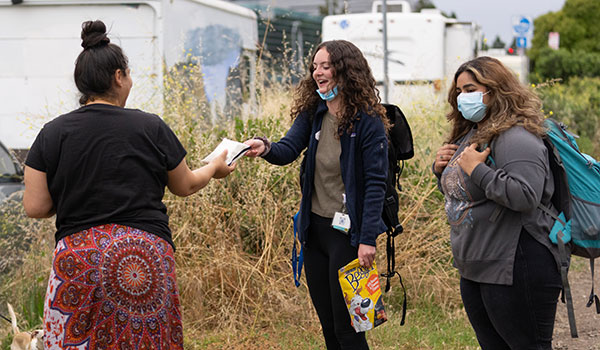
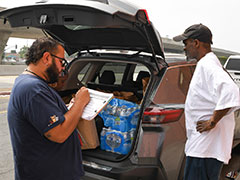
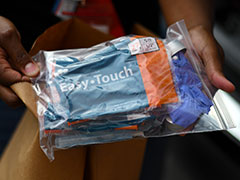
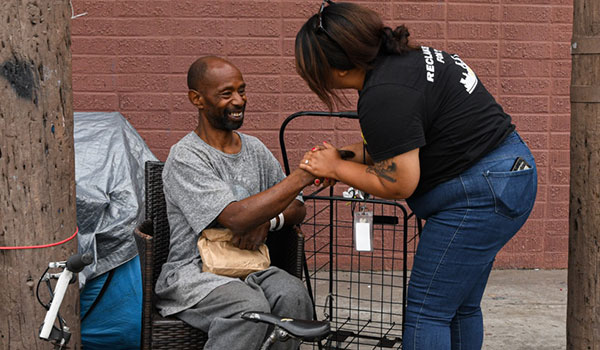


 Naloxone is a Food and Drug Administration (FDA) approved medication that reverses an opioid overdose.
It acts as an opioid receptor antagonist – meaning that it binds to opioid receptors and reverses and blocks the effects of other opioids.
In the event of an opioid overdose, naloxone can quickly restore breathing to an individual whose breathing has slowed or stopped.
Naloxone is a Food and Drug Administration (FDA) approved medication that reverses an opioid overdose.
It acts as an opioid receptor antagonist – meaning that it binds to opioid receptors and reverses and blocks the effects of other opioids.
In the event of an opioid overdose, naloxone can quickly restore breathing to an individual whose breathing has slowed or stopped.
 Fentanyl is a powerful synthetic opioid that is similar to morphine but is 50 to 100 times more potent causing a sharp, nationwide increase in overdose deaths involving illicitly manufactured fentanyl
which has contaminated heroin, methamphetamine, ecstasy, illicitly manufactured pills, and other recreational drugs. Fentanyl test strips (FTS) are a form of inexpensive drug testing technology
that can help detect the presence of fentanyl and other fentanyl-analogs in a drug sample prior to use.
Fentanyl is a powerful synthetic opioid that is similar to morphine but is 50 to 100 times more potent causing a sharp, nationwide increase in overdose deaths involving illicitly manufactured fentanyl
which has contaminated heroin, methamphetamine, ecstasy, illicitly manufactured pills, and other recreational drugs. Fentanyl test strips (FTS) are a form of inexpensive drug testing technology
that can help detect the presence of fentanyl and other fentanyl-analogs in a drug sample prior to use.

